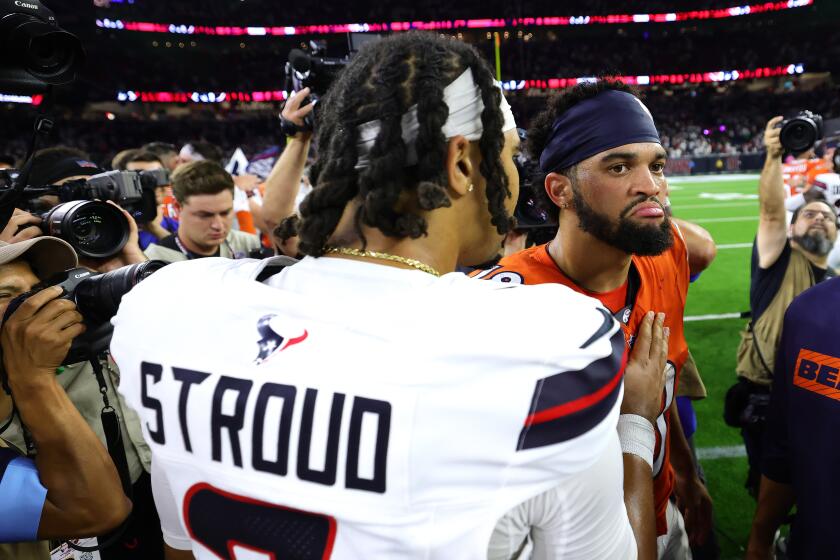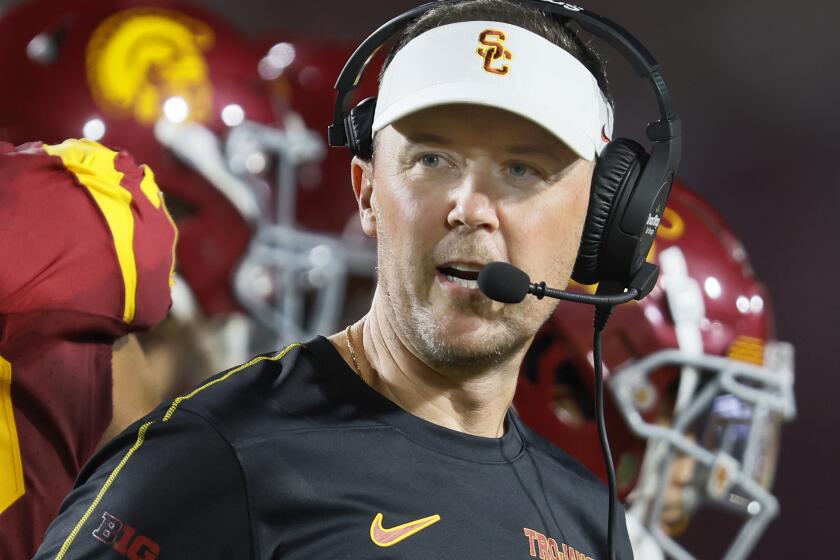They Make It a Risky Business
LenDale White never started a game for USC last season, but he was good enough to lead the nation in scoring and, at times, steal the thunder from Heisman Trophy-winning teammate Reggie Bush.
But what White has done -- or hasn’t done -- in the last few months is enough to make pro coaches very uneasy about making him an early selection in next weekend’s NFL draft.
White is the latest in a long line of risky draft prospects. Pass him by, and a rival team could wind up with a punishing touchdown machine. Select him, and you could be paying millions to a player who so far hasn’t felt an urgency to stay in shape and is hobbling into the draft on a bum hamstring.
“You have to be very sure of yourself,” said Bill Walsh, former coach of the San Francisco 49ers. “You have to be able to say, look, there’s a risk here and we’re willing to accept the risk. If it doesn’t work, it’s just part of doing business.”
In a sense, every prospect is a risk. Bush might be too small to be an every-down back in the NFL. Scouts have questioned quarterback Matt Leinart’s arm strength and mobility. No one knows how quickly quarterback Vince Young can adjust to running a traditional pro offense. Quarterback Jay Cutler never had a winning season at Vanderbilt.
But no prospect has taken a more conspicuous tumble in recent months than White, who will enter the draft without having run a 40-yard dash. He didn’t work out at the combine, instead announcing he would do so at USC’s April 2 pro day. There, however, his afternoon consisted of little more than a sub-par bench-press performance. It was later determined he had a slight hamstring tear. That diagnosis raised eyebrows around the league, considering it was made by a chiropractor and not a physician.
“I think there’s some concern [about White] because he’s shown a repeated history of not preparing and not staying in shape,” said an NFL personnel executive, speaking on condition of anonymity. “But the talent’s there, and people will take a flier on him. You can’t afford to miss on your first two picks, so it does make it risky to take him.”
It looks as if at least two teams might be willing to roll the dice on White in the first round. Carolina is considering using the 27th pick on him and Pittsburgh, which has the 32nd pick, sees him as a potential Jerome Bettis replacement.
Teams take risks with one eye on the upside. When Pittsburgh selected Ben Roethlisberger with the 11th pick in 2004, they were betting he could make the dramatic step up from the Mid-American Conference, something not everyone thought possible. Two years later, he was hoisting the Lombardi Trophy after Super Bowl XL.
Eight years ago, 19 teams passed on the chance to select Marshall receiver Randy Moss -- the Cincinnati Bengals doing so twice -- because they flinched at his troubled past and playbook-thick rap sheet. The Minnesota Vikings took him with the 21st pick, and Moss responded with perhaps the greatest rookie season in league history.
Does one good risk deserve another? Not necessarily. A year later, the Vikings used a first-round pick to select Michigan State defensive end Dimitrius Underwood, who signed a five-year, $5.3-million contract, then walked away from training camp after one day. He said he had no desire to play football and eventually cut ties with the Vikings. He later tried comebacks with Miami and Dallas, but his career was cut short by psychological problems that included at least two suicide attempts.
Before he entered the draft, Underwood’s odd ways caught the attention of his college coach, Nick Saban, who told reporters, “I think Dimitrius’ behavior over a little bit of time here has been a little bit unusual.”
A player doesn’t have to be selected in the first two rounds to be a significant risk. Denver gambled last year when it took former Ohio State star Maurice Clarett with the final selection of the third round. He showed up out of shape -- just as he was at the combine -- and soon was out of a job.
USC’s White, who grew up in Denver, was quick to distance himself from that Buckeye bust when he returned to his hometown.
“I am not Maurice Clarett,” he told reporters in Denver.
“I never violated team rules. I never robbed anyone,” he said. “I just haven’t run a 40-yard dash and I gained five pounds. That’s all that has happened.”
Considering the millions of dollars the NFL invests in its players, it’s not surprising teams place a lot of importance on interviews, not just a prospect’s height, weight and 40-yard-dash time.
“The interviews are very enlightening -- it’s probably the best thing you can do,” Washington Redskin Coach Joe Gibbs said. “You get a chance to have some communication with them and feel what kind of personality they have. You know how fast they can run and how high they can jump and you watch them athletically. But that’s not the No. 1 thing you’re looking for. You’re trying to see what kind of person they are.”
Ernie Accorsi, general manager of the New York Giants, believes that’s better achieved through face-to-face interviews rather than standard psychological examinations.
“I know psychologists love those questions,” Accorsi said. “I’m more worried about whether he can go out on the edge and get to the passer. I don’t get into all that stuff. That’s supposed to mean something.
“I remember when I was given a psychological test for one job, it said ‘Would you ever kill an animal?’ Well, [yes] a rattlesnake ready to bite my son, but I wouldn’t touch a puppy. What does that mean? I guess that means something to a psychologist. You can look at a player on tape, and we do a lot of research on these kids and how they perform from high school, so we have a pretty good case history on our kids when they get there. And I’m just a believer that the past indicates future behavior. People revert for the most part.”
When is a risky pick not that risky after all? When he’s taken so late in the draft a team can afford to gamble. The Oakland Raiders selected Eli Herring in the sixth round of the 1995 draft, for instance, even though the Brigham Young lineman had informed teams he wouldn’t play Sundays because of his religious beliefs. He never reported to camp.
Eleven years earlier, Dallas made track star Carl Lewis the 334th selection out of 336, taking him in the 12th round even though he had no college playing experience and no known ambition to play in the pros. Explained a team spokesman: “We drafted the best athlete available in the 12th round, and you can’t do much better than that.”
Apparently, the Chicago Bulls couldn’t agree more.
They used a throwaway pick to draft him too.
*
(BEGIN TEXT OF INFOBOX)
Rolling the dice at the draft
Some risky picks at the NFL draft that were worth taking, and some that weren’t:
RISKS THAT PAID OFF ...
* Randy Moss, WR, Marshall (21st overall, Minnesota, 1998) -- His rap sheet and checkered past scared away 19 other teams. He made them regret it with perhaps the best rookie season in NFL history.
* Terrell Suggs, DE, Arizona State (10th overall, Baltimore, 2003) -- Only three weeks before the draft, he was injured in a fight at a three-on-three basketball tournament. Turned out to be defensive rookie of the year.
* Warren Sapp, DT, Miami (12th overall, Tampa Bay, 1995) -- Slipped in draft amid allegations he tested positive for marijuana while at Miami. Made seven consecutive Pro Bowls from 1997 through 2003.
* Sebastian Janikowski, K, Florida State (17th overall, Oakland, 2000) -- Kickers are almost never drafted in the first round, especially ones with a slew of arrests. Has made 80.8% of his field-goal attempts, best in Raider history.
* Brian Urlacher, LB, New Mexico (ninth overall, Chicago, 2000) -- A lot of scouts questioned whether he could successfully make the transition from college safety to NFL linebacker. Four Pro Bowls later, it’s safe to say he has.
RISKS THAT DIDN’T ...
* Lawrence Phillips, RB, Nebraska (sixth overall, St. Louis, 1996) -- Assaulted his girlfriend during his last season at Nebraska, and that was merely a hint of the trouble to come. Never realized his potential as a pro.
* R. Jay Soward, WR, USC (29th overall, Jacksonville, 2000) -- Character issues surfaced before the draft, but Jaguars took him anyway. He wound up being suspended several times before his pro career eventually fizzled to an end.
* Cade McNown, QB, UCLA (12th overall, Chicago, 1999) -- After the scouting combine, a lot of scouts questioned whether McNown had the arm strength to make it in the pros. The Bears were 1-6 with him starting as a rookie, he suffered a shoulder injury, and his career never got off the ground.
* Dan McGwire, QB, San Diego State (16th overall, Seattle, 1991) -- Seattle was hoping that McGwire, the 6-foot-8 younger brother of slugger Mark McGwire, would be head and shoulders above the competition. His career totals: two touchdowns, six interceptions.
* Lamar King, DE, Saginaw Valley State (22nd overall, Seattle, 1999) -- Mike Holmgren’s first draft pick as Seattle’s coach/general manager was a doozy. He reached for King, a small-school standout who wound up collecting only 12 sacks in five injury-riddled seasons.
Go beyond the scoreboard
Get the latest on L.A.'s teams in the daily Sports Report newsletter.
You may occasionally receive promotional content from the Los Angeles Times.




